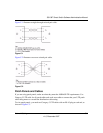
GS108T Smart Switch Software Administration Manual
Virtual Local Area Networks (VLANs) B-3
v1.0, December 2007
– For the VLAN with VID 10, specify the following members: port 1 (U), port 2 (U), and
port 3 (T).
– For the VLAN with VID 20, specify the following members: port 4 (U), port 5 (T), and
port 6 (U).
3. With the VLAN configuration that you set up, the following situations produce results as
described:
• If an untagged packet enters port 1, the switch tags it with VID 10. The packet has access
to port 2 and port 3. The outgoing packet is stripped of its tag to leave port 2 as an
untagged packet. For port 3, the outgoing packet leaves as a tagged packet with VID 10.
• If a tagged packet with VID 10 enters port 3, the packet has access to port 1 and port 2. If
the packet leaves port 1 or port 2, it is stripped of its tag to leave the switch as an untagged
packet.
• If an untagged packet enters port 4, the switch tags it with VID 20. The packet has access
to port 5 and port 6. The outgoing packet is stripped of its tag to become an untagged
packet as it leaves port 6. For port 5, the outgoing packet leaves as a tagged packet with
VID 20.
Port-Based VLANs
Port-based VLANs help to confine broadcast traffic to the switch ports. This switch allows up to
eight port-based VLAN groups. Any one port can belong to different VLAN groups. The default
VLAN group is a port-based VLAN that has all ports belonging to VLAN 1.
Packets received by the switch are treated in the following way:
• When a packet enters a port, it can proceed only to ports with the same VLAN membership as
the ingress port.
• If a port on the switch does not have a common VLAN membership with the source port, the
packet is dropped.


















